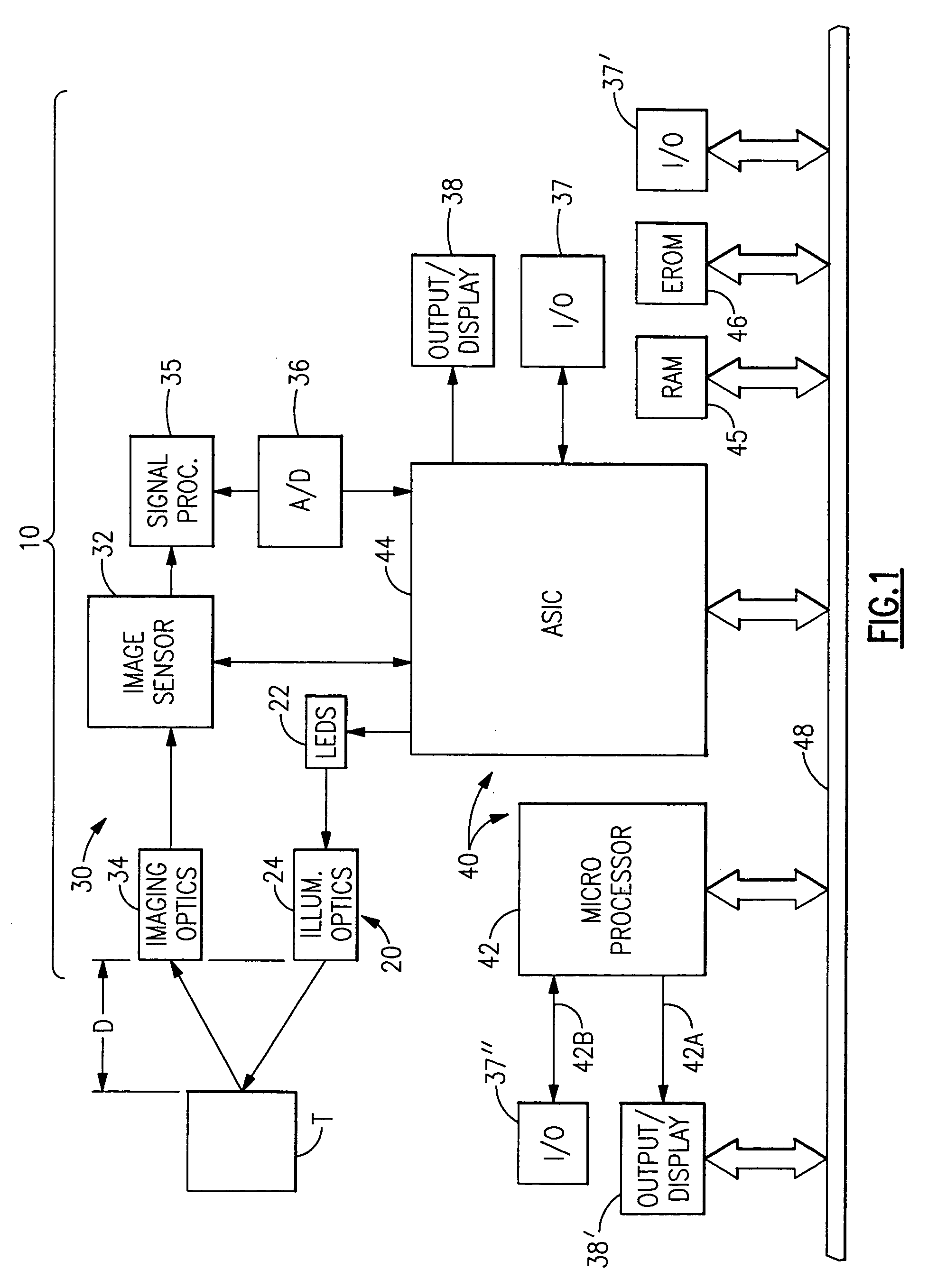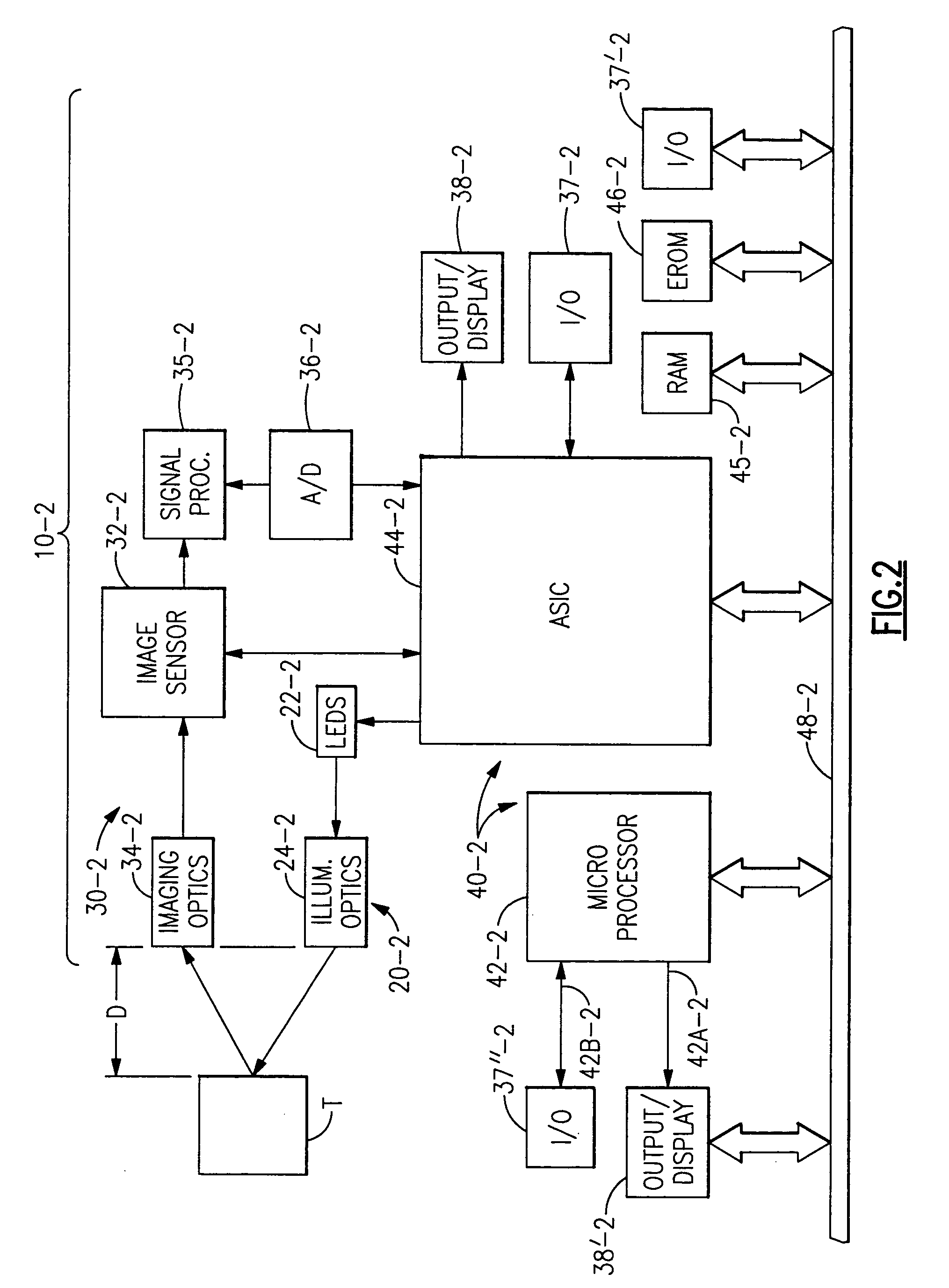Optical reader having solid-state image sensor
a solid-state image and optical reader technology, applied in the field of optical readers having solid-state image sensors, can solve the problems of affecting the reading process, etc., and unable to be dealt with in this way for a long tim
- Summary
- Abstract
- Description
- Claims
- Application Information
AI Technical Summary
Benefits of technology
Problems solved by technology
Method used
Image
Examples
first embodiment
[0410] First Embodiment
[0411] Turning now to the Drawing, and initially to FIG. 43, a bar code reader 5010 is shown. Suitable hardware comprising the reader is commercially available as model ST3000-22 from Welch Allyn, Skaneateles Falls, N.Y., and the invention can be practiced therewith provided that certain modifications disclosed herein are made. The bar code reader 5010 is a portable self-contained hand-held unit that is capable of scanning and decoding bar code symbologies. The unit could be as large as 10.times.4.times.0.3 inches and weigh as much as 10 oz, but It preferably has dimensions of about 71 / 2.times.31 / 2.times.2 inches, and draws 1.4 watts average during scanning, and 0.83 watts during decoding with the illumination off. It preferably weighs 7.5 oz. The unit can resolve bar code elements that are 5 mils in width.
[0412] The bar code reader 5010 has conventional optics 15 and a plurality of 660 nm light emitting diodes 5016 that illuminate a narrow strip of a bar code...
example 1
[0436] Using the embodiment described above, standard PDF symbols (shown representatively at reference numerals 5400 in FIGS. 46-48) were read repeatedly for 30 seconds. As previously explained, a "read" is a full operation, including scanning of the bar code information, decoding, and output of the decoded information. In this example the read head of the hand-held bar code reader was maintained in contact with the data carrier and in alignment with the row axes of the bar code symbol. There was no tilt with respect to the plane of the data carrier. Ambient room lighting conditions were present. The decoded information is shown as character sequences 5410, 5510, 5610. The results are shown in table 1.
6TABLE 1 Number of reads in 30 Seconds - According to Invention Text Error Correction Level Chars 0 1 2 3 4 5 6 7 8 100 54 61 69 75 76 75 50 27 15 200 31 43 48 59 57 53 39 24 14 400 22 28 24 25 28 25 23 18 13 800 11 14 13 16 15 16 13 12 8 1200 8 9 9 10 10 9 7 -- --1600 5 6 6 7 7 7 -- -...
second embodiment
[0439] Second Embodiment
[0440] Turning now to FIG. 49, there is shown a schematic of a portion of a second embodiment of the invention, wherein similar parts have the same reference numbers as in FIGS. 43 and 44. This embodiment has the same general construction as the first embodiment, except now the photodetector is realized as a two dimensional CCD matrix 5117 comprised of elements such as 5120-5120, instead of a linear CCD array. During a scanning operation the CCD array simultaneously acquires an image of the entire two dimensional bar code symbol 5018. The signals developed by the CCD matrix 5117 are multiplexed in row-wise fashion through MUX 5125, and then coupled to the signal processing circuitry 5020. With the use of the multiplexer, the two dimensional array 5117 in a single scanning operation thus emulates multiple scans executed by the linear array 5017 of the first embodiment, and the signal format is entirely acceptable to the signal processing circuitry 5020, and th...
PUM
 Login to View More
Login to View More Abstract
Description
Claims
Application Information
 Login to View More
Login to View More - R&D
- Intellectual Property
- Life Sciences
- Materials
- Tech Scout
- Unparalleled Data Quality
- Higher Quality Content
- 60% Fewer Hallucinations
Browse by: Latest US Patents, China's latest patents, Technical Efficacy Thesaurus, Application Domain, Technology Topic, Popular Technical Reports.
© 2025 PatSnap. All rights reserved.Legal|Privacy policy|Modern Slavery Act Transparency Statement|Sitemap|About US| Contact US: help@patsnap.com



